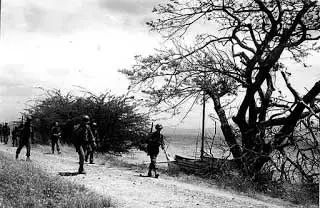A Bauan Native’s 1945 Escape from Certain Death at the Hands of the Japanese
By March 1945, Allied liberation forces led by the United States Army had left their coop in Nasugbu, where the 8th Army had landed late in January of that year, to start the campaign to expel the Japanese from Southern Luzon, including Batangas.
According to US Army records1, by 9 March, liberation forces had reached the Calumpang Pensinsula, capturing the town of Bauan that same day. Resistance was comparatively light since most of the forces of the Japanese Imperial Army erstwhile stationed there had been ordered to withdraw and consolidate a defensive position at Mt. Makulot in Cuenca.
Still, clearing operations at the peninsula would last several days as Japanese forces scattered, some attempting to flee to Mindoro. It was not until the 16th of the month that the area was declared clear of the Japanese2.
It must have been during the Allied campaign at the Calumpang Peninsula that a daring escape by a native of Bauan from certain death at the hands of the Japanese was documented by a school teacher in the so-called “historical data” for the Barrio of Magalang-galang in Bauan3.
According to the narration written by one Pedro Alcayde, five native men of the barrio of Magalang-galang were accosted by Japanese soldiers “in the earlier part of March 1945” and “forced to carry their ammunition with them to their headquarters located at the southern side of Mailayin Mountain of Mabini, Batangas.”
The men were Eulogio Magboo, Leovigildo Panganiban, Maximo Anglo, Benigno Panganiban and Evaristo Anglo.
Reaching the road opposite the Mabini Elementary School, suddenly four American aircraft flew overhead. The date must have been 10 March, when US Army Air Force (USAAF) fighter-bombers “hit Japanese Army positions in Batangas.” This was documented in a chronology of USAAF operations in World War II4.
Attempting to take advantage of the distraction, Leovigildo Panganiban, “put down his load and tried to run to escape from the cruel Japs.” One of the Japanese soldiers, however, caught sight of him escaping and took a shot, killing Panganiban instantly by the side of the road.
When the USAAF planes had gone, the small party resumed its journey to the Japanese headquarters at the side of Mailayin Mountain. Once there, instead of thanking the Filipinos for their assistance and setting the men free to go home, the Japanese started committing the sort of atrocities for which they became notorious late in the war.
A-20 aircraft supported US Army ground troops in Batangas in 1945. Image source: USAAF [Public domain], via Wikimedia Commons. Three of the remaining Bauan natives – Magboo, Maximo Anglo and Benigno Panganiban – “were killed one by one by hammering their heads with a big piece of wood and striking their stomachs with their sharp pointed bayonets.”
While the Japanese were occupied killing the three, the fourth man, Evaristo Anglo, must have been feverishly attempting without being noticed to free himself from the ropes with which he was tied.
Alcayde concluded the story:
“Fortunately, the last man by the name of Evaristo Anglo luckily succeeded in untying himself and ran as fast as he could through the thick forest in the midst of darkness. He was then very thankful to God the Almighty for he was able to return home alive despite his fear of bullets.”
It was scant consolation, but towards the end of the month, barrio folks in Magalang-galang managed to kill two Japanese soldiers who went hiding in the barrio. One was killed “by some active civilians” hiding in a foxhole dug by no less than Magboo, one of the victims killed at Japanese headquarters in Mabini.
The other was found hiding, of all places, in the house of one Leonardo Anglo, presumably a relation of Maximo and Ernesto. This Japanese “was brought by the civilians to a big tree by the side of one big ravine and was tied to the big tree and then killed.”
Full transcription: History and Cultural Life of Magalang-galang.
2 “US Army in World War II, The War in the Pacific, Triumph in the Philippines” by Robert Ross Smith, published in 1993 by the Office of the Chief of Military History, Department of the Army, Washington D.C.
3 “History and Cultural Life of Magalang-galang,” online at the National Library of the Philippines Digital Collections.
4 “United States Army Air Forces in World War II: Combat Chronology 1941-1945,” compiled by Kit C. Carter and Robert Mueller, published 1991 by the Center for Air Force History, Washington DC.

